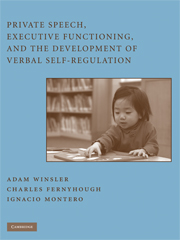Book contents
- Frontmatter
- Contents
- List of Contributors
- Foreword
- Introduction
- Part I Theoretical and Biological Foundations
- 1 Still Talking to Ourselves after All These Years: A Review of Current Research on Private Speech
- 2 Dialogic Thinking
- 3 The Executive Functions of Language in Preschool Children
- 4 The Neuropsychology of Covert and Overt Speech: Implications for the Study of Private Speech in Children and Adults
- Part II Language, Communication, Social Cognition, and Awareness
- Part III Symbols and Tools throughout the Life Span
- Part IV Motivational and Educational Applications
- Index
- References
4 - The Neuropsychology of Covert and Overt Speech: Implications for the Study of Private Speech in Children and Adults
from Part I - Theoretical and Biological Foundations
Published online by Cambridge University Press: 29 July 2009
- Frontmatter
- Contents
- List of Contributors
- Foreword
- Introduction
- Part I Theoretical and Biological Foundations
- 1 Still Talking to Ourselves after All These Years: A Review of Current Research on Private Speech
- 2 Dialogic Thinking
- 3 The Executive Functions of Language in Preschool Children
- 4 The Neuropsychology of Covert and Overt Speech: Implications for the Study of Private Speech in Children and Adults
- Part II Language, Communication, Social Cognition, and Awareness
- Part III Symbols and Tools throughout the Life Span
- Part IV Motivational and Educational Applications
- Index
- References
Summary
Although by 370 b.c. Hippocrates had concluded that the brain played a role in the generation of behavior (Carlson, 2003), it was not until seminal studies performed in the 1860s that specific human cognitive abilities began to be mapped onto regions of the brain with some accuracy. Postmortem studies by Paul Broca and Karl Wernicke allowed individuals' cognitive deficits to be linked tentatively to lesions discovered in specific brain regions. It was not until almost a century later that the advent of noninvasive neuroimaging techniques allowed the functional neuroanatomy of the brain of a living individual to be visualized for the first time. The striking contemporary images produced by functional magnetic resonance imaging (fMRI) have allowed researchers to examine in detail the neural correlates of a wide range of cognitive processes such as visual perception, speech perception, and short-term memory.
Contemporary neuroimaging studies of speech production are typically designed to isolate regions of the brain involved in one of the “core processes” (Indefrey & Levelt, 2000) of speech, such as lexical retrieval (selecting an appropriate word) or phonological code retrieval (retrieving information about the sound of the word). Such studies have generated extensive documentation of the neural correlates of overt and inner speech, as well as the neural activation that differentiates them. The latter is of particular relevance for private speech researchers because it may help shed light on what happens when private speech “goes underground” (Vygotsky, 1934/1986, p. 33) to form inner speech.
Information
- Type
- Chapter
- Information
- Publisher: Cambridge University PressPrint publication year: 2009
References
Accessibility standard: Unknown
Why this information is here
This section outlines the accessibility features of this content - including support for screen readers, full keyboard navigation and high-contrast display options. This may not be relevant for you.Accessibility Information
- 7
- Cited by
